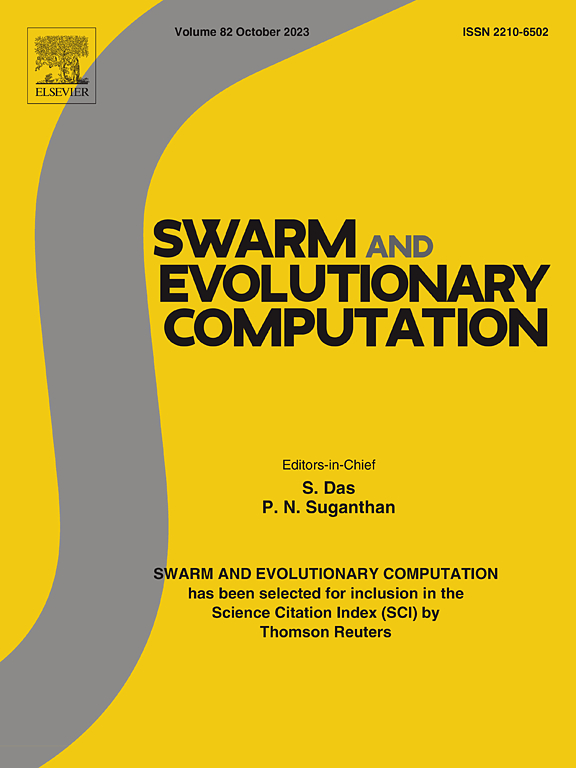从元启发式搜索痕迹中学习算子选择的离线数据驱动过程
IF 8.5
1区 计算机科学
Q1 COMPUTER SCIENCE, ARTIFICIAL INTELLIGENCE
引用次数: 0
摘要
经过训练的基于奖励的动作分类引擎(TRACE)是在元启发式搜索期间捕获算子结果数据,训练分类器来预测算子是否会产生改进的解决方案,并在未来的搜索运行中部署这些模型来指导邻域选择的一般过程。本文介绍了TRACE-VNS,这是通用变量邻域搜索(GVNS)的模块化扩展,应用于有能力车辆路径问题(CVRP),其中邻域选择由这些离线训练的模型驱动。分类器在从GVNS轨迹中提取的特征上进行训练,包括动作历史、图形度量、时间状态和上置信度界(UCB)指标。12个分类器,包括树集成、神经网络和基于核的模型,使用曲线下的精确召回面积(PR-AUC)来评估预测质量。实证结果表明,在84个CVRP实例中,TRACE-VNS比传统GVNS的收敛速度和最终解的质量都有所提高。详细的特征重要性分析确定了强大的贡献者,为有效选择作业者提供了见解。TRACE不需要运行时探索或反馈循环,并且可以通过最小的结构适应推广到其他元启发式。本文章由计算机程序翻译,如有差异,请以英文原文为准。
An offline data-driven process for learning operator selection from metaheuristic search traces
Trained Reward-based Action Classification Engine (TRACE) is a general process for capturing operator outcome data during metaheuristic search, training classifiers to predict whether an operator will yield an improved solution, and deploying those models to guide neighborhood selection during future search runs. This study introduces TRACE-VNS, a modular extension of General Variable Neighborhood Search (GVNS) applied to the Capacitated Vehicle Routing Problem (CVRP), where neighborhood selection is driven by these offline-trained models. Classifiers are trained on features extracted from GVNS traces, including action history, graph metrics, temporal state, and Upper Confidence Bound (UCB) indicators. Twelve classifiers, including tree ensembles, neural networks, and kernel-based models, are benchmarked using the Precision–Recall Area Under the Curve (PR-AUC) to evaluate predictive quality. Empirical results show that TRACE-VNS improves convergence speed and final solution quality over conventional GVNS across 84 CVRP instances. A detailed feature importance analysis identifies strong contributors, offering insights into the effective selection of operators. TRACE requires no runtime exploration or feedback loops and can generalize to other metaheuristics through minimal structural adaptation.
求助全文
通过发布文献求助,成功后即可免费获取论文全文。
去求助
来源期刊

Swarm and Evolutionary Computation
COMPUTER SCIENCE, ARTIFICIAL INTELLIGENCEC-COMPUTER SCIENCE, THEORY & METHODS
CiteScore
16.00
自引率
12.00%
发文量
169
期刊介绍:
Swarm and Evolutionary Computation is a pioneering peer-reviewed journal focused on the latest research and advancements in nature-inspired intelligent computation using swarm and evolutionary algorithms. It covers theoretical, experimental, and practical aspects of these paradigms and their hybrids, promoting interdisciplinary research. The journal prioritizes the publication of high-quality, original articles that push the boundaries of evolutionary computation and swarm intelligence. Additionally, it welcomes survey papers on current topics and novel applications. Topics of interest include but are not limited to: Genetic Algorithms, and Genetic Programming, Evolution Strategies, and Evolutionary Programming, Differential Evolution, Artificial Immune Systems, Particle Swarms, Ant Colony, Bacterial Foraging, Artificial Bees, Fireflies Algorithm, Harmony Search, Artificial Life, Digital Organisms, Estimation of Distribution Algorithms, Stochastic Diffusion Search, Quantum Computing, Nano Computing, Membrane Computing, Human-centric Computing, Hybridization of Algorithms, Memetic Computing, Autonomic Computing, Self-organizing systems, Combinatorial, Discrete, Binary, Constrained, Multi-objective, Multi-modal, Dynamic, and Large-scale Optimization.
 求助内容:
求助内容: 应助结果提醒方式:
应助结果提醒方式:


